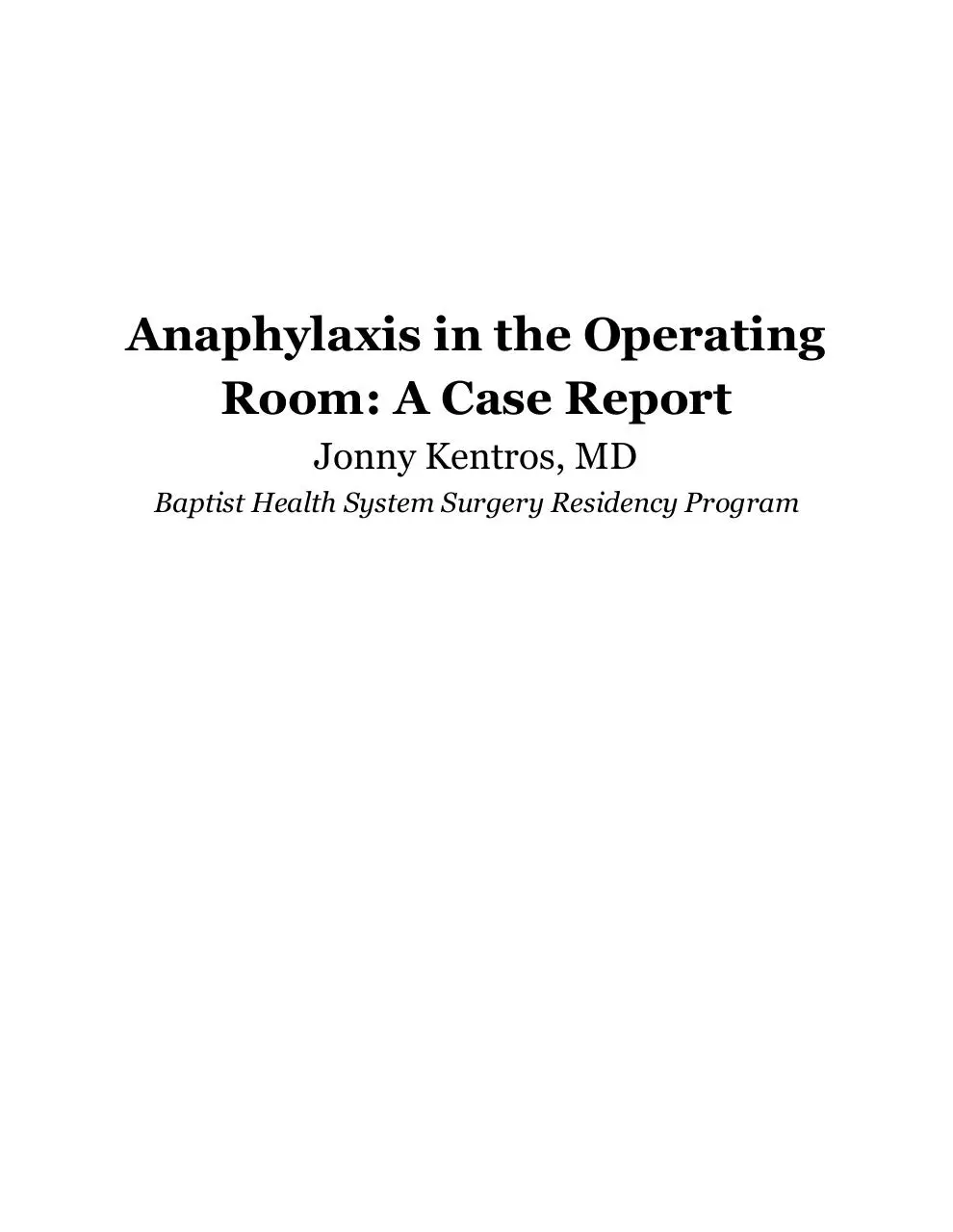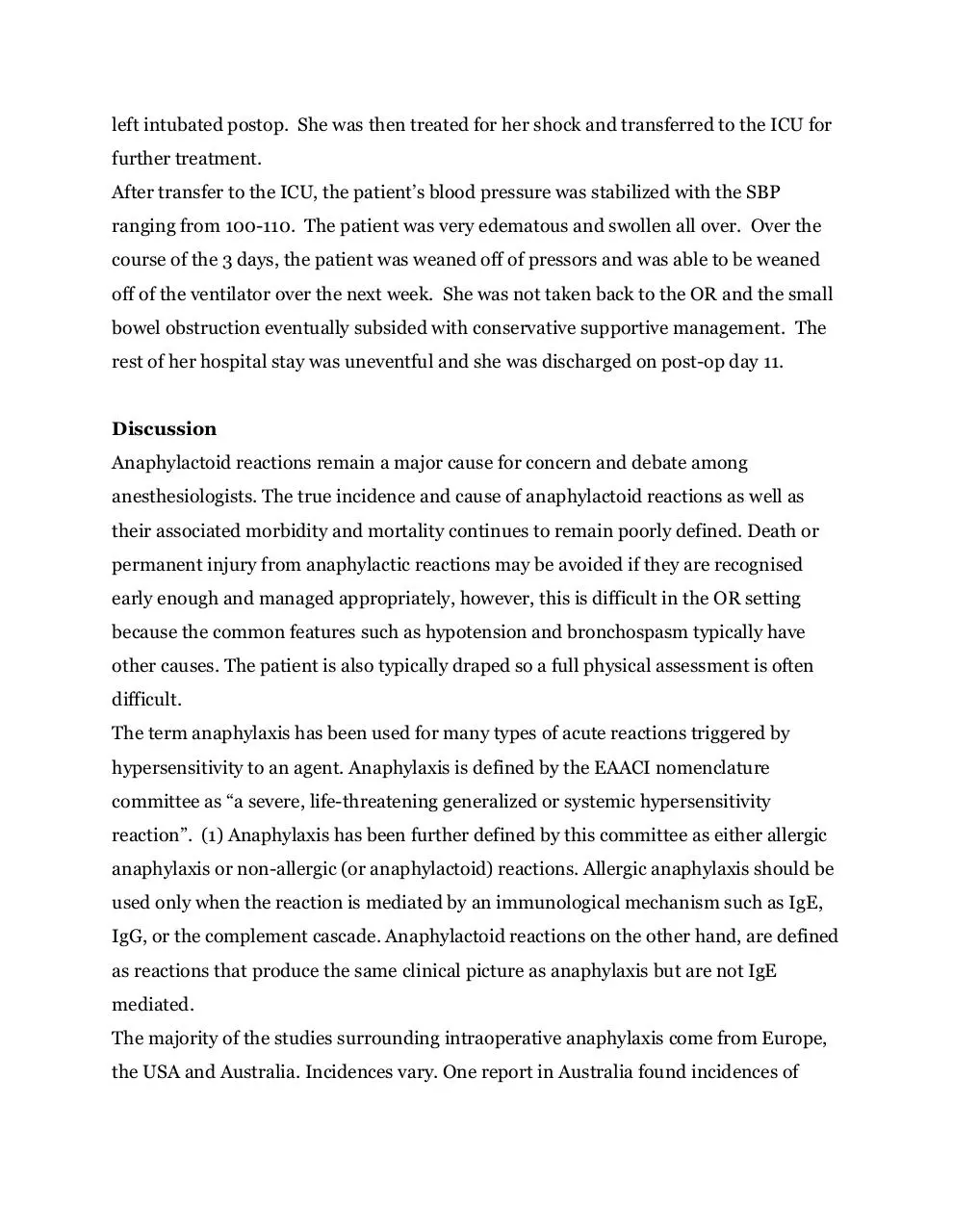CaseReport (PDF)
File information
This PDF 1.4 document has been generated by , and has been sent on pdf-archive.com on 31/03/2014 at 06:16, from IP address 71.45.x.x.
The current document download page has been viewed 761 times.
File size: 132.14 KB (8 pages).
Privacy: public file





File preview
Anaphylaxis in the Operating
Room: A Case Report
Jonny Kentros, MD
Baptist Health System Surgery Residency Program
Introduction
Anaphylactic reactions in the OR are a common occurrence. Anaphylaxis is an acute,
multisystem, potentially lethal syndrome due to the rapid release of basophil and
mast-cell derived mediators into the bloodstream due to a perceived outside pathogen.
Typically the most common reason for anaphylaxis in the OR are muscle relaxants,
however, the incidence of intraoperative anaphylaxis due to latex is increasing. The
operating room setting is unique in the practice of medicine in that many different drugs
are given in rapid succession and any one of these drugs can produce potentially life
threatening anaphylaxis. Because of the large number of drugs given over a relatively
short time, it is not always clear which drug patients is the cause of the patient’s reaction
when they occur.
Case Description
A 64-year-old black female with a history of multiple small bowel obstructions which
have been surgically corrected presented with sudden onset abdominal pain with dry
heaving. According to her daughter, she started to have sudden-onset abdominal pain in
her upper quadrants and on the left side starting at 2:00 p.m. that day. Her daughter
came home at 4 p.m. and upon finding the patient, immediately brought her to the
emergency room. The patient said that she was dry heaving but did not actually vomit.
She also says that, as far as she knows, her bowel habits have been normal. During her
ER workup, the patient had a seizure in the ER witnessed by the ER physician. She has
no history of seizures and this is her first episode. She then had a CT of her head
performed which showed no focal intracerebral lesion, mass effect, hemorrhage,
extracerebral collection or other acute process. Her white count was 14.8 and her CT
scan showed dilated small bowel in the mid and upper abdomen with stranding, free
fluid, questionable intussusception of a small portion of the colon, a true hernia, and a
small amount of bowel edema. These findings were consistent with a mechanical small
bowel obstruction. She was given Ativan in the ER for her seizure. The patient had
known allergies to sulfa drugs, penicillin and ancef. According to patient’s daughter, the
patient also had a heart attack in the OR after administration of ancef during one
previous operation.
The patient’s past medical history was significant for chronic obstructive pulmonary
disease, hypertension, diabetes mellitus type II, diverticulosis, and obstructive sleep
apnea. The patient’s past surgical history was significant for a Hartmann’s procedure, a
Hartmann’s procedure reversal, multiple exploratory laparotomies for small bowel
obstructions, and multiple hernia repairs with mesh, the most recent in 2009. Her
current medications included Calan, Claritin, Aspirin, Advair, K-Dur, Zestril, Zocor,
Hydrochlorothiazide, Norvasc, Clonidine, Proventil. The patient denied and alcohol,
tobacco or illicit drug use. Physical exam was significant for tenderness to palpation in
the left lower and upper quadrants. Her abdomen was non-distended, soft and had
normal bowel sounds. The rest of her physical exam was normal except for the fact that
the patient was drowsy due to her postictal state.
Upon admission a nasogastric tube was placed stat which immediately had 200cc output.
She was made NPO and scheduled for the OR for the following morning for an
exploratory laparotomy. The following morning the patient was taken to the operating
room and placed in supine position. Once adequate general endotracheal anesthesia had
been obtained, the patient's abdomen was prepped and draped in sterile fashion. A
midline incision was made with a 10 blade scalpel, and this was extended through
subcutaneous tissues using Bovie electrocautery. The fascia was divided midline with
Bovie electrocautery. Upon entry into the abdomen, there were dense adhesions with
bowel that stuck to the abdominal wall. Shortly after entry into the abdomen, the
patient became hypotensive. The hypotension was initially responsive to fluid, but after
a short time, the patient became extremely unstable and was placed on epinephrine and
levophed. Her systolic blood pressure was in the 50s, and it was elected to stop the case
to stabilize the patient. We were ultimately able to free some adhesions with some loops
of small bowel but were unable to do a full exploration. The fascia was closed using a
running #1 looped PDS followed by closure of the skin with skin staples. The patient was
left intubated postop. She was then treated for her shock and transferred to the ICU for
further treatment.
After transfer to the ICU, the patient’s blood pressure was stabilized with the SBP
ranging from 100-110. The patient was very edematous and swollen all over. Over the
course of the 3 days, the patient was weaned off of pressors and was able to be weaned
off of the ventilator over the next week. She was not taken back to the OR and the small
bowel obstruction eventually subsided with conservative supportive management. The
rest of her hospital stay was uneventful and she was discharged on post-op day 11.
Discussion
Anaphylactoid reactions remain a major cause for concern and debate among
anesthesiologists. The true incidence and cause of anaphylactoid reactions as well as
their associated morbidity and mortality continues to remain poorly defined. Death or
permanent injury from anaphylactic reactions may be avoided if they are recognised
early enough and managed appropriately, however, this is difficult in the OR setting
because the common features such as hypotension and bronchospasm typically have
other causes. The patient is also typically draped so a full physical assessment is often
difficult.
The term anaphylaxis has been used for many types of acute reactions triggered by
hypersensitivity to an agent. Anaphylaxis is defined by the EAACI nomenclature
committee as “a severe, life-threatening generalized or systemic hypersensitivity
reaction”. (1) Anaphylaxis has been further defined by this committee as either allergic
anaphylaxis or non-allergic (or anaphylactoid) reactions. Allergic anaphylaxis should be
used only when the reaction is mediated by an immunological mechanism such as IgE,
IgG, or the complement cascade. Anaphylactoid reactions on the other hand, are defined
as reactions that produce the same clinical picture as anaphylaxis but are not IgE
mediated.
The majority of the studies surrounding intraoperative anaphylaxis come from Europe,
the USA and Australia. Incidences vary. One report in Australia found incidences of
between 1 in 5,000 and 1 in 25,000 general inductions with a mortality rate of 3.4%1. A
further study also performed in Australia found the incidence of anaphylaxis to be
between 1 in 10,000 and 1 in 20,0001. There have been a few other studies performed
since 1980s and all of them have incidences roughly between 1 in 5,000 and 1 in 20,000
with mortality rates ranging between 3-6%.
Many agents are used during induction of general anesthesia. Muscle relaxants (such as
Succinylcholine, atracurium, vecuronium, pancuronium), induction agents, (such as
barbiturates, etomidate, propofol) Narcotics (such as fentanyl, meperidine, morphine),
colloids, antibiotics, radiocontrast, blood products, and latex are all commonly used
products in the OR. The patient in this case study received fentanyl, propofol, anectine,
rocuronium, lidocaine, albuterol, lactated ringers and a fluoroquinolone around the time
of induction.
Without a doubt, according to multiple different studies, the most common cause of
anaphylactic reactions in the OR is due to muscle relaxants. In a comprehensive study
from France comparing all agents involved in anaphylactic reactions between January 1,
1999 and Dec 31, 2000, muscle relaxants led the list causing 58.2% of reactions. Latex
was the second most common with 16.7%, antibiotics were third with 15.1%. The
remaining agents combined accounted for only 10% of all reactions. This study also found
a significant female predominance of 70% of all reactions. The predominance was
irrespective of the causal agent3. Of the muscle relaxants, rocuronium was found to be
the most common cause with 43.7% of cases followed by succinylcholine at 22.6%. There
is still controversy around this as some consider the increased incidence of reactions to
rocuronium due to the drug itself whereas others consider the increased incidence
reflective of increased market use3. Other studies have been performed which have
similar conclusions as this study and report muscle relaxants being the causal agents of
anaphylactic reactions at around 60%2.
Early recognition and clinical diagnosis of anaphylaxis is paramount in the treatment.
Clinical features include hypotension, tachycardia or bradycardia (in 10% of cases),
cutaneous flushing, rash or urticaria, and bronchospasm. Previous history of any sort of
allergies or anaphylactic reactions should also raise the index of suspicion for
intraoperative anaphylaxis if the patient begins showing some of the symptoms. As with
our patient, multiple allergies as well as a history of intraoperative anaphylaxis helped
provide early diagnosis and treatment.
Immediate treatment involves first using the ABC approach. All potential causal agents
should be removed and the case should be immediately terminated. Oxygen should be
administered, and the patient’s legs should be elevated. Intravenous epinephrine should
also be administered and if multiple doses are necessary, a continuous infusion should be
considered. The patient should also be receiving a high rate of intravenous fluids, either
normal saline or lactated ringer solution. The secondary treatment includes
administration of intravenous chlorpheniramine and hydrocortisone. If blood pressure
does not respond to this, a second vasopressor should be added. Bronchospasm should
be treated with an intravenous infusion of salbutamol. Patient should be transferred to
the ICU and blood samples should be drawn to test for Mast Cell Tryptase to confirm
diagnosis.
Cross sensitivities of muscle relaxants is fairly common. Current recommendations from
the Journal of the Association of the Anesthetists of Great Britain and Ireland suggest
that if a patient has a history of anaphylaxis due to a suspected muscle relaxant, the
patient should be skin prick tested with all muscle relaxants. The patient should
optimally avoid any muscle relaxant use in the future, however, if surgery and the use of
a muscle relaxant is necessary one should be chosen that had a negative skin test.
Conclusion
Due to this data, it is most likely that our patient had an anaphylactic reaction to the
muscle relaxant given which was rocuronium. The patient had a vague history of
intraoperative anaphylactic reactions in the past which were originally attributed to
ancef, however, because the patient had another intraoperative anaphylactic reaction,
the patient more than likely reacted to a muscle relaxant both times. Due to the large
number of drugs used over a short period of time, her earlier anaphylactic reaction was
likely mis-attributed to ancef. Unfortunately, it was not possible to obtain the anesthesia
record from that episode because it was performed decades ago at an outside institution.
The anesthesiologist on call luckily promptly recognized the reaction and because it was
early in the case, closure was not difficult. The patient was treated appropriately and a
good outcome was obtained. In the future, as with the guidelines mentioned above,
rocuronium should be avoided and the patient should have a skin prick test, testing all of
the different kinds of muscle relaxants. If surgery is necessary in the future, the skin
prick test should serve as a guide for muscle relaxant use and extreme caution should be
taken.
References
1.
Lieberman P. Anaphylactic reactions during surgical and medical procedures. J
Allergy Clin Immunol 2002;110: S64–9.
2.
Harper NJ, Dixon T, Dugue P, Edgar DM, Fay A, Gooi HC, Herriot R, Hopkins P,
Hunter JM, Mirakian R, Pumphrey RS, Seneviratne SL, Walls AF, Williams P,
Wildsmith JA, Wood P, Nasser AS, Powell RK, Mirakhur R, Soar J: Suspected
anaphylactic reactions associated with anaesthesia. Anaesthesia 2009;
64:199–211.
3.
Mertes PM, Laxenaire M-C, Alla F. Anaphylactic and anaphylactoid reactions
occurring during anesthesia in France in 1999–2000. Anesthesiology.
2003;99:536 –545. (IIb)
Download CaseReport
CaseReport.pdf (PDF, 132.14 KB)
Download PDF
Share this file on social networks
Link to this page
Permanent link
Use the permanent link to the download page to share your document on Facebook, Twitter, LinkedIn, or directly with a contact by e-Mail, Messenger, Whatsapp, Line..
Short link
Use the short link to share your document on Twitter or by text message (SMS)
HTML Code
Copy the following HTML code to share your document on a Website or Blog
QR Code to this page

This file has been shared publicly by a user of PDF Archive.
Document ID: 0000154908.